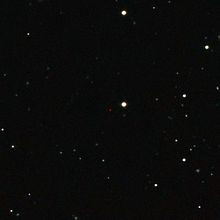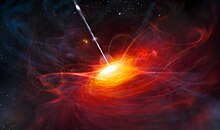ULAS J1120 + 0641
ULAS J112001.48 + 064124.3 , often abbreviated to ULAS J1120 + 0641 , is a quasar with a redshift of z = 7.085. According to ULAS J1342 + 0928 it is the second most distant known quasar and at the same time the first known quasar with a redshift z> 7.
discovery
ULAS J1120 + 0641 was first cataloged in September 2010 in the eighth data package of the UKIRT Infra Red Deep Sky Survey ( UKIDSS ) from the UK Infrared Telescope (UKIRT) on Mauna Kea in Hawaii . The name of the quasar is derived from UKIDSS Large Area Survey (ULAS) and the position in the sky: Right ascension 11h 20min and the declination + 06 ° 41 '. The letter "J" indicates the point in time to which the coordinates refer. The quasar is located in the constellation Leo near σ Leonis and only a few degrees away from the galaxy Messier 66 .
The quasar was discovered with an infrared telescope, although the light was originally emitted as UV radiation from the quasar. Infrared light has a longer wavelength and is lower in energy than UV light. This change in energy and wavelength comes about through the expansion of the universe, which causes a red shift , similar to the Doppler effect in sound waves.
UKIDSS is a photometric study in the near infrared range. The sky survey covers the wavelength bands Z, Y, J, H and K , for which the earth's atmosphere is permeable. Among other things, UKIDSS was intended to search specifically for quasars with a redshift of z> 6.5. Up to this distance, quasars can be captured with conventional telescopes in the optical range. At greater distances, the corresponding areas of the spectrum are already red-shifted so far that they can no longer be recorded. Accordingly, the original discovery only indicated a photometric redshift with z phot > 6.5.
The UKIDSS- survey launched on 13 May 2005. The signal from Ulas J1120 + 0641 was included in the 8th data packet of the survey, which was released on September 3, 2010; five years after the survey began. The photometric characteristics corresponded to what had been expected from a quasar with a redshift of z> 6.5. A comparison with the data from the Sloan Digital Sky Survey (SDSS) and further investigations at the UKIRT and the Liverpool telescope seemed to confirm the suspicion.
Therefore, on the night of November 27th to 28th, 2010 a first spectrum was recorded with the "Gemini Multi-Object Spectrograph" (GMOS) at the Gemini-Nord Observatory . The spectrum showed a steep increase at a wavelength of λ = 0.98μm, while at shorter wavelengths ("blueward") hardly any significant emissions could be detected. ULAS J1120 + 0641 was thus clearly identified as a quasar with a redshift of about z = 7.08.
For the detailed analysis, partial spectra were recorded and merged with the Focal Reducer and low dispersion Spectrograph 2 ( FORS2 ) on the Very Large Telescope and with the Gemini Near-Infrared Spectrograph (GNIRS) at the Gemini-Nord Observatory. FORS2 covered the wavelength range from 0.75 - 1.03 μm and GNIRS covered the range from 0.90 - 2.48 μm. It was thus possible to determine the redshift with a value of 7.085 ± 0.003. The discovery of ULAS J1120 + 0641 was announced on June 29, 2011 and the object was even further away than hoped with a redshift of 7.085.
description
Ulas J1120 + 0641 has a measured red shift of z = 7.085, which corresponds to a co-moving distance ( "comoving distance") of 28,850,000,000 light years. Until 2017, it was the farthest quasar ever observed. The light emitted by the quasar that is now being observed was created less than 770 million years after the Big Bang, i.e. around 12.9 billion years ago. The estimated luminosity of the quasar is 6.3 · 10 13 times the luminosity of the sun.
The energy output is generated by a supermassive black hole that has 2.0 (+ 1.5 / -0.7) · 10 9 solar masses. While the black hole supplies the quasar with energy, the light does not come from the black hole itself. It has been known since the late 1970s that the enormous luminosity of quasars comes from an accretion disk that surrounds them and is accelerated and heated by the gravitational effect of the black hole Gas and dust.
The spectrum of ULAS J1120 + 0641 has the typical features of a strongly redshifted quasar, in particular a Lyman alpha forest and a Gunn-Peterson trough . However, these features do not represent properties of ULAS J1120 + 0641 itself, but are first impressed on the light of the quasar during its journey through the intergalactic medium .
No significant radio source could be found at the position of ULAS J1120 + 0641 . ULAS J1120 + 0641 is accordingly classified as a "radio-quiet" Quasar. In the X-ray light , however, ULAS J1120 + 0641 could be perceived as a point source with the X-ray telescopes Chandra and XMM-Newton . The X-ray spectrum also indicates that at the point in time when the X-ray light was emitted, the accretion rate of the black hole was well above the Eddington accretion rate.
meaning
The light from ULAS J1120 + 0641 was emitted for a period of time before the theoretically predicted transition of the intergalactic medium from an electrically neutral to an ionized state had ended. Quasars may have been an important source of energy in this process known as the reionization era . A quasar from before this transition is of considerable theoretical interest. Because of their high luminosity in the UV range, quasars are one of the best sources for researching the reionization era.
The Gunn-Peterson-Trough and the Lyman-Alpha-Forest in the spectrum of ULAS J1120 + 0641 allow conclusions to be drawn about the distribution of neutral hydrogen in the intergalactic medium during this reionization phase. A Gunn-Peterson trough can be detected at ULAS J1120 + 0641 for redshifts from z = 7.04 to z = 6.122. A Gunn-Peterson trough is imprinted on the spectrum of a quasar when its light passes through areas of the intergalactic medium in which residues of non-reionized neutral hydrogen are evenly distributed. The absorption lines of the Lyman-Alpha-Forest arise when the light passes through local areas with a higher concentration of neutral hydrogen. Every time it passes through such a neutral hydrogen cloud, the light of the quasar is impressed with a new absorption line with a slightly changed redshift. The spectrum of ULAS J1120 + 0641 shows 7 Lyman alpha lines at redshifts between z = 6.122 and z = 5.858.
It is unclear how the black hole in the center of ULAS J1120 + 0641 was able to reach the enormous mass of over 2.0 (+ 1.5 / -0.7) · 10 9 solar masses in the short time since the Big Bang . A stellar black hole can be assumed to be the forerunner of the supermassive black hole , which was formed during the core collapse of a Population III star. In this case, however, the black hole would have had to grow continuously with an accretion rate that exceeds the Eddington accretion rate by 1.5 times ("Super-Eddington accretion"). Theoretically, however, this should not be possible, because if the Eddington accretion rate is exceeded, the radiation pressure becomes so high that it destroys the accretion disk around the black hole and no more mass can be added to it. Whether and, if so, how with ULAS J1120 + 0641 and many other quasars a Super-Eddington accretion has taken place is still unclear.
Web links
- ESO: Most distant quasar discovered June 29, 2011
- scinexx .de: Astronomers discover the most distant quasar June 30, 2011
- Raumfahrer.net: Most distant quasar discovered June 30, 2011
Individual evidence
- ↑ a b c d e f g h i j k DJ Mortlock, St. J. Warren, BP Venemans, M. Patel, PC Hewett, RG McMahon, Ch. Simpson, T. Theuns, EA Gonzáles-Solares, A. Adamson , S. Dye, NC Hambly, P. Hirst, MJ Irwin, E. Kuiper, A. Lawrence, & HJA Röttgering: A luminous quasar at a redshift of z = 7,085. In: Nature , Vol. 474, pp. 616–619, 2011. (digitized version )
- ^ A b E. Bañados, BP Venemans, Ch. Mazzucchelli, EP Farina, F. Walter, F. Wang, R. Decarli, D. Stern, X. Fan, FB Davies, JF Hennawi, RA Simcoe, ML Turner, H .-W. Rix, J. Yang, DD Kelson, GC Rudie, & JM Winters: An 800-million-solar-mass black hole in a significantly neutral Universe at redshift 7.5. In: Nature , Vol. 553, pp. 473-476, 2017. (Preprint)
- ↑ a b ESO : Most distant quasar discovered. In: Press Releases Science , eso1122de-at, (online) Retrieved on August 17, 2018
- ↑ IAU : Specifications concerning designations for astronomical radiation sources outside the solar system. 7 p., 2008. (digitized version)
- ^ Gemini Observatory : The Most Distant Quasar: Both Headache and Opportunity. In: Gemini Observatory Press Release , June 29, 2011. (online) Retrieved August 18, 2018
- ^ A b P.C. Hewett, SJ Warren, SK Leggett & ST Hodgkin: The UKIRT Infrared Deep Sky Survey ZY JHK Photometric System: Passbands and Synthetic Colors. In: Monthly Notices of the Royal Astronomical Society , Vol. 367, Issue 2, pp. 454–468, 2006. (digitized version )
- ↑ GA Shields: Thermal continuum from accretion disks in quasars. In: Nature , Vol. 272, pp. 706–708, 1978 (abstract)
- ↑ a b c R. Barnett, SJ Warren, GD Becker, DJ Mortlock, PC Hewett, RG McMahon, C. Simpson, & BP Venemans: Observations of the Lyman series forest towards the redshift 7.1 quasar ULAS J1120 + 0641. In: Astronomy & Astrophysics , Vol. 601, A16, 11 S., 2017. (pdf)
- ↑ E. Momjian CL Carilli, F. Walter & B. Venemans: The Highest Redshift Quasar at z = 7085: A Radio Quiet source. In: The Astronomical Journal , Vol. 147, No. 6, 3 pp., 2013. (preprint)
- ↑ a b M. J. Page, C. Simpson, DJ Mortlock, SJ Warren, PC Hewett, BP Venemans & RG McMahon: X-rays from the redshift 7.1 quasar ULAS J1120 + 0641. In: Monthly Notices of the Royal Astronomical Society Letters , Vol. 440, pp. L91 – L95, 2014. (Preprint)
- ↑ X. Fan, VK Narayanan, RH Lupton, MA Strauss, GR Knapp, RH Becker, RL White, L. Pentericci, SK Leggett, Z. Haiman, JE Gunn, Z. Ivezic, DP Schneider & 21 other co-authors : A Survey of z> 5.8 Quasars in the Sloan Digital Sky Survey I: Discovery of Three New Quasars and the Spatial Density of Luminous Quasars at z ∼ 6 . In: The Astronomical Journal , Vol. 122, No. 6, pp. 2833–2849, 2001. (digitized version )
- ^ J. Miralda-Escudé: Reionization of the Intergalactic Medium and the Damping Wing of the Gunn-Peterson Trough. In: The Astrophysical Journal , Vol. 501, pp. 15-22, 1998. (Preprint)
- ↑ S. Collin, C. Boisson, M. Mouchet, A.-M. Dumont, S. Coupé, D. Porquet & E. Rokaki: Are quasars accreting at super-Eddington rates? In: Astronomy and Astrophysics , Vol. 388, pp. 771–786, 2002. (digitized version )

